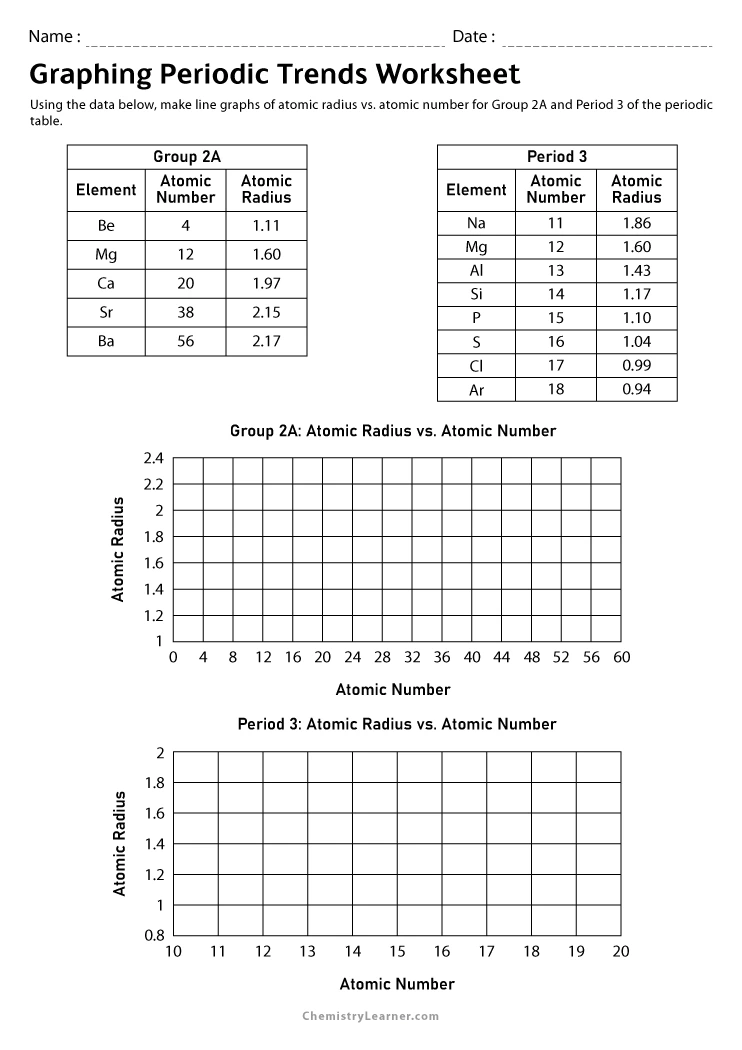Remember those days in high school chemistry, staring at the periodic table, trying to decipher its secrets? You might have even stumbled upon those infamous periodic trends review problems, leaving you scratching your head in confusion. Well, fret no more! This comprehensive guide will equip you with the tools to conquer those periodic trends review problems, understand their nuances, and emerge victorious from any exam.

Image: www.vrogue.co
Let’s embark on a journey of understanding these periodic trends, exploring their significance, and tackling those tricky review problems with confidence. We’ll dive into the fascinating world of ionization energy, electron affinity, and electronegativity, unraveling the patterns that bind the elements together.
Understanding the Periodic Trends
The periodic table isn’t just a random collection of elements; it’s a carefully organized map of chemical behavior. Periodic trends are the recurring patterns in the properties of elements as we move across a period or down a group in the table. These trends are crucial for understanding how elements react, form bonds, and interact with each other.
Key Periodic Trends
Here are the main periodic trends you’ll encounter in your review problems:
- Ionization Energy (IE): The energy required to remove an electron from a gaseous atom.
- Electron Affinity (EA): The change in energy when an electron is added to a gaseous atom.
- Electronegativity (EN): The ability of an atom to attract electrons in a chemical bond.
- Atomic Radius: The distance between the nucleus and the outermost electron shell.
Explaining the Trends
Understanding these trends starts with appreciating the forces at play within atoms. Let’s use ionization energy as an example:
- Nuclear Charge: As you move across a period, the number of protons in the nucleus increases, leading to a stronger attraction between the nucleus and the electrons. This makes it harder to remove an electron, thus increasing ionization energy.
- Shielding Effect: As you move down a group, the number of electron shells increases, creating a shielding effect. This means the outer electrons are less tightly held by the nucleus, leading to lower ionization energy.
Similar explanations apply to other periodic trends. For instance, electronegativity increases across a period because the attraction for electrons increases due to the increased nuclear charge. However, it decreases down a group as the electrons become farther from the nucleus and less attracted.

Image: ar.inspiredpencil.com
Conquering Periodic Trends Review Problems
Now, let’s tackle those challenging review problems. You’ll often be asked to predict the relative values of periodic properties like ionization energy or electronegativity for different elements. Here’s how to approach them:
- Visualize the periodic table: Mentally picture the position of the elements in question. This helps you quickly grasp their relationships.
- Apply the trends: Consider the general principles we discussed before. Does the trend increase or decrease across a period or down a group?
- Consider exceptions: Remember that there are exceptions to the general trends. For instance, some elements exhibit anomalies in their electron affinity or ionization energy due to special electron configurations.
- Practice, practice, practice: The best way to master periodic trends is through practice. Solve numerous problems, analyze different scenarios, and refine your understanding of the trends.
Tips and Expert Advice
Here’s a set of tips to further enhance your understanding of periodic trends and excel in review problems:
- Use mnemonic devices: Create catchy phrases or acronyms to remember the trends. These can be particularly helpful for remembering the order of increasing properties.
- Create flashcards: Prepare flashcards listing elements and their properties. This helps you memorize values and quickly compare them.
- Engage in active learning: Instead of passively reading textbooks, actively participate in the learning process. Solve problems, ask questions, and discuss concepts with peers.
Remember, learning about periodic trends goes beyond memorizing values. It’s about grasping the underlying principles that govern the behavior of elements. By actively engaging with the subject, you’ll not only succeed in your review problems but also gain a profound understanding of chemistry.
Periodic Trends FAQs
Here are some frequently asked questions about periodic trends and review problems:
- Q: How do I determine the trend in ionization energy for elements across a period?
A: Ionization energy generally increases across a period because the increasing nuclear charge pulls the electrons more tightly, making it harder to remove an electron.
- Q: What are the exceptions to the periodic trends?
A: There are several exceptions to the general trends, especially for elements with unusual electron configurations. For instance, the ionization energy of nitrogen is higher than that of oxygen. This is because nitrogen has a half-filled p-orbital, which is more stable than a partially filled p-orbital in oxygen.
- Q: What resources can I use to practice periodic trends problems?
A: Numerous online resources, textbooks, and study guides offer practice problems related to periodic trends. You can also find helpful videos and tutorials on platforms like YouTube.
Periodic Trends Review Problems Answer Key
Conclusion
Understanding periodic trends is a key step towards mastering the fundamentals of chemistry. By grasping the underlying principles, practicing diligently, and utilizing effective learning strategies, you can confidently approach even the most challenging periodic trends review problems. So, are you ready to delve deeper into the fascinating world of periodic trends and unlock their secrets?






